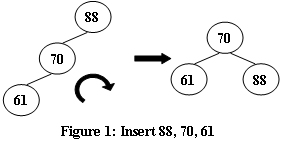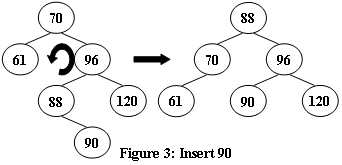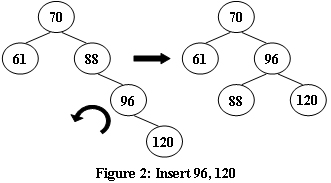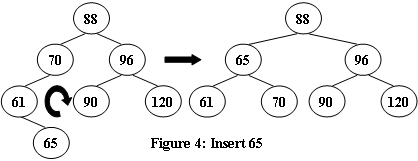1066 Root of AVL Tree(25 分)
An AVL tree is a self-balancing binary search tree. In an AVL tree, the heights of the two child subtrees of any node differ by at most one; if at any time they differ by more than one, rebalancing is done to restore this property. Figures 1-4 illustrate the rotation rules.


Now given a sequence of insertions, you are supposed to tell the root of the resulting AVL tree.
Input Specification:
Each input file contains one test case. For each case, the first line contains a positive integer N (≤20) which is the total number of keys to be inserted. Then N distinct integer keys are given in the next line. All the numbers in a line are separated by a space.
Output Specification:
For each test case, print the root of the resulting AVL tree in one line.
Sample Input 1:
5
88 70 61 96 120
Sample Output 1:
70
Sample Input 2:
7
88 70 61 96 120 90 65
Sample Output 2:
88经过俩个小时的努力终于把AVL最基本的用法整出来了。
code
#pragma warning(disable:4996)
#include <iostream>
#include <algorithm>
using namespace std;
class AVLtree {
public:
int value=0, bf=0, height = 0;
AVLtree *left = NULL, *right = NULL;
AVLtree* opLL() {
AVLtree* pa = this, *pb = left, *pc = ((left)->left);
pa->left = pb->right;
pb->right = pa;
return pb;
}
AVLtree* opRR() {
AVLtree* pa = this, *pb = right, *pc = (right->right);
pa->right = pb->left;
pb->left = pa;
return pb;
}
AVLtree* opRL() {
AVLtree* pa = this, *pb = right, *pc = (right->left);
pb->left = pc->right;
pc->right = pb;
pa->right = pc->left;
pc->left = pa;
return pc;
}
AVLtree* opLR() {
AVLtree* pa = this, *pb = left, *pc = (left->right);
pb->right = pc->left;
pc->left = pb;
pa->left = pc->right;
pc->right = pa;
return pc;
}
};
int getheight(AVLtree* p);
int getbf(AVLtree* p);
AVLtree* insert(AVLtree* p, int x) {
if (p == NULL) {
p = new AVLtree;
p->value = x;
return p;
}
if (x >= p->value) p->right = insert(p->right, x);
else p->left = insert(p->left, x);
return p;
}
AVLtree* blance(AVLtree* p) {
if (p == NULL) return NULL;
p->left = blance(p->left);
p->right = blance(p->right);
if (getbf(p) > 1) {
if (getbf(p->left) > 0) p = p->opLL();
else p = p->opLR();
}
else if (getbf(p) < -1) {
if (getbf(p->right) > 0) p = p->opRL();
else p = p->opRR();
}
return p;
}
int getheight(AVLtree* p) {
if (p == NULL) return 0;
return max(getheight(p->left), getheight(p->right)) + 1;
}
int getbf(AVLtree* p) {
return p->bf = (p->left == NULL ? 0 : getheight(p->left)) - (p->right == NULL ? 0 : getheight(p->right));
}
void print(AVLtree* p) {
if (p == NULL) return;
cout << p->value << '-' <<getbf(p)<< ' ';
print(p->left);
print(p->right);
}
int main() {
int n, x;
cin >> n;
AVLtree *p=NULL;
while (n--) {
cin >> x;
p = insert(p, x);
//print(p);
p = blance(p);
//print(p);
}
cout << p->value << endl;
system("pause");
return 0;
}
